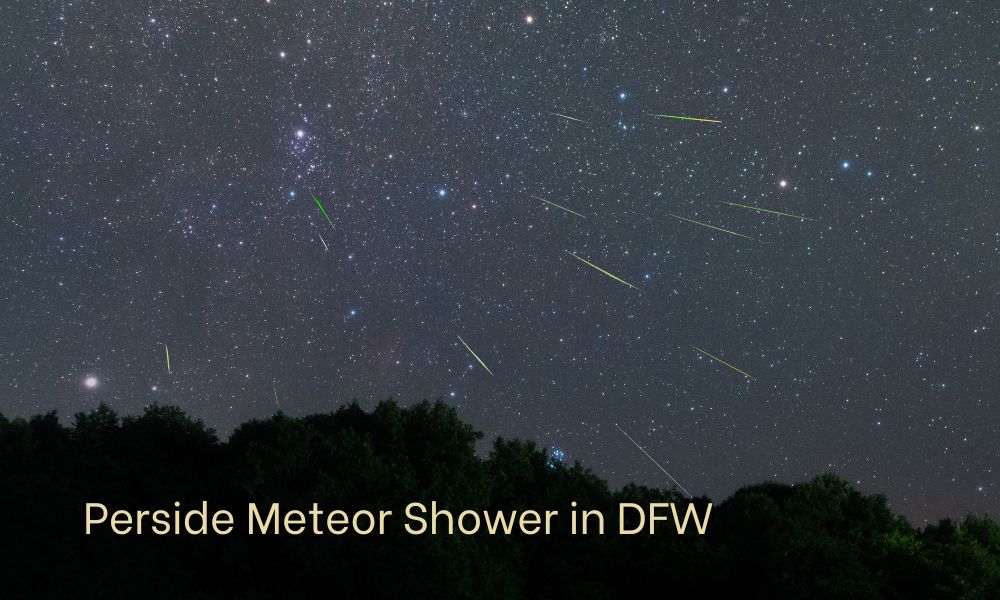🌠 What & When: The Perseid Meteor Shower
Active period: approximately July 17 – August 23, 2025 (Thrillist, People.com)
Peak viewing: overnight August 12–13, especially from late evening to pre‑dawn local time (People.com)
Rate: under ideal dark skies, expect 50–100 meteors per hour; typical rural rates: 50–75 ZHR (zenith hourly rate) (People.com)
Special 2025 note:
The Sturgeon Moon (~84 % full) arrives right around peak—moonlight will wash out faint meteors, cutting visibility by ~75 %. Still, bright fireballs and meteors remain stunning (American Meteor Society).
Better viewing windows are July 18–28 (pre‑new moon) and after August 16 (post‑old moon), when moonlight interference is minimal (Live Science).
🔭 Origins: What Are Perseid Meteors Made Of?
Source: Debris shed from Comet 109P/Swift–Tuttle, which orbits the Sun every ~133 years (American Meteor Society).
Composition: A mixture of dust, ice grains, and tiny rocky particles, ranging from sand-sized to pebble-sized. These travel at ~37 mi/s (59 km/s) .
When entering the atmosphere at high speed, they vaporize, creating the bright streaks we see.
📜 History & Name
Recorded since AD 36, making them one of the oldest documented meteor showers (Wikipedia).
The name “Perseids” (Latin Perseides; Greek Perseidai) was coined around 1866–1867, popularized by Italian astronomer Giovanni Schiaparelli (Etymology Online).
Named for the shower’s radiant—the point in the sky near the Perseus constellation from which meteors appear to emanate (Wikipedia).
Historically known as the “Tears of St. Lawrence”, referencing August 10 in Christian tradition—said to be the martyr’s tears (Etymology Online).
🎯 Best Viewing Times from DFW
Prime window: Late night to pre‑dawn hours, typically midnight to ~5 AM CDT (NBC 5 Dallas-Fort Worth).
Start early: Even after sunset (~10‑11 PM), you may spot “earthgrazers”—meteors that skim the atmosphere and leave long, colorful trails (WIRED).
Avoid moon interference: For 2025, July 18–28 and after August 16 are optimal due to darker skies.
🔍 How Good Will It Be in 2025?
Peak rates predicted: 50–100 meteors/hour, though moonlight may reduce this to ~25–30/hour at best (Live Science, People.com).
However, the shower is known for bright fireballs, which stand out even under moonlit skies (American Meteor Society).
Best experience lies in catching early or late parts of the shower when the Moon is low or absent.
🧭 Viewing from DFW: Best Spots (“DFW Meteorplex”)
Light pollution is the biggest enemy. Here are top local and near-DFW dark sky venues:
Cedar Hill State Park (18 mi from Dallas) – lakeside stargazing, minimal light pollution (Thrillist)
Lake Mineral Wells State Park – further west, excellent dark skies; stargazing-friendly (CBS News)
Benbrook or Eagle Mountain Lake – waterfront views away from city glow (CBS News)
Harry S. Moss Park (White Rock Creek Greenbelt) – within the city, slight elevation and darker pockets (Thrillist)
Frisco Commons Park – generally good, but check for park hours; used for star-parties (Thrillist)
Cooper Lake or Dinosaur Valley State Park – ~1–2 hours drive, great dark skies during organized star parties (Thrillist)
🗓 Ideal 2025 Viewing Plan for DFW
| Phase | Date Range | Best Time | Why |
|---|---|---|---|
| Early Viewing | July 18–28 | After midnight | No moon, dark skies, catching rising rates |
| Pre‑peak Viewing | Aug 1–11 | After midnight | Building meteor activity, manageable Moon |
| Peak Viewing | Aug 12–13 | Midnight–2 AM | Peak activity; expect ~25–50/hr under moonlight |
| Post‑peak Viewing | Aug 16–24 | Midnight–3 AM | Weaker but darker skies yield bright meteors |
🌌 Viewing Tips
Find dark skies: at least 30 mins south/west of Dallas.
Bring essentials: reclining lawn chairs or blankets, snacks, bug spray, and warm layers.
Give it time: your eyes need 20–30 mins to adapt; avoid screens.
Scan broadly: don’t look at Perseus only—meteors streak across the entire sky.
Be patient & comfy: peak showings come gradually; settle in for 1–2 hours or more.
✨ Why It Matters & What to Expect
A 2,000-year-old celestial tradition—people have watched these since ancient China and Rome (Live Science, Wikipedia, People.com, WIRED, American Meteor Society, noirlab.edu, Friends of Murphys Point Park).
A connection to Comet Swift–Tuttle, a mammoth 26 km-wide nucleus, whose debris we now see blazing overhead (NASA Science).
Even with moonlight, bright Perseid fireballs provide a breathtaking experience, making 2025 still truly worth it.
✅ Final 2025 Perseid Strategy for DFW
Head out early: July 18–28 for dark, moon-free skies—or brave Aug 12–13 for peak, despite the Moon.
Choose your site: Cedar Hill SP, Lake Mineral Wells, or any darker greenbelt area.
Bring comfort & patience: A blanket, chair, snack, and your best company.
Stay late: Peak is after midnight; meteors increase up to dawn.
Whether it’s bright fireballs slicing through moonlit skies on peak nights or a more serene show mid-July, the Perseids deserve your stargazing time. With the right setup, you’ll be rewarded—DFW offers surprisingly great options right in our Meteorplex backyard.
